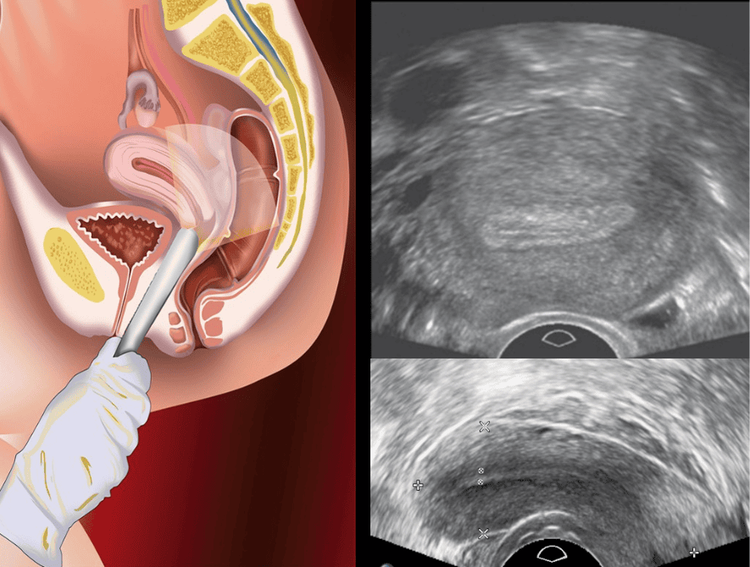This is an automatically translated article.
The article is professionally consulted by Master, Doctor Nguyen Thanh Nam - Radiologist - Department of Diagnostic Imaging - Vinmec Danang International General Hospital.Transvaginal transvaginal ultrasound (transvaginal or rectal for pediatric patients, patients who have not had sex) is a pelvic ultrasound technique indicated by specialists to examine and diagnose diseases in the ovaries, fallopian tubes, cervix ... of women. This is a technique of high value in diagnosis and makes an important contribution to the treatment of diseases related to the reproductive system.
1. What is transducer ultrasound?
Transvaginal Ultrasonography (Transvaginal Ultrasonography) is a technique that uses high-frequency ultrasound waves to penetrate through the vagina to display images of the uterus, ovaries and other parts of the reproductive organs with high resolution. High resolution helps to accurately diagnose gynecological diseases.Depending on the diagnostic purpose, the doctor will appoint an anal transvaginal ultrasound or a vaginal transvaginal ultrasound for the patient:
Transrectal ultrasound: Indicated to detect pathologies in the pelvic region in pediatric or unmarried patients. Vaginal transvaginal ultrasound: Indicated in cases of early pregnancy, women with signs of ectopic pregnancy, assessment of tumors in the ovaries, uterus, fetal heart check , evaluate the origin of the tumor in the subframe. In addition, transvaginal ultrasound is also used to check the status of pus-filled fallopian tubes, water retention, determine the time of ovulation ...

Kỹ thuật siêu âm đầu dò âm đạo
2. When should transducer ultrasound be performed?
2.1. The body has abnormal signs When the body has the following symptoms and signs, the patient should go for an ultrasound examination:Pelvic pain Unexplained vaginal bleeding Check for fibroids uterus , ovarian cysts Check the IUD insertion site , need to confirm that the IUD is in the correct position Evaluation of pelvic health Cases of menstrual disorders .

Tinh trạng u nang buồng trứng ở phụ nữ
What disease does transducer ultrasound detect? In some cases, gynecologists will be ordered to have a transvaginal ultrasound if signs of an ectopic pregnancy (a pregnancy that implants outside the uterus, usually in a fallopian tube) are suspected. tumors (ovarian cysts, uterine fibroids), assessment of uterine thickness, measurement of egg size to determine the time of ovulation for artificial insemination techniques ...
Also The transrectal ultrasound method also helps diagnose diseases in the pelvic region, rectum, prostate,...
2.3. Diagnostic examination for pregnant women For pregnant women, doctors may also order transvaginal ultrasound during pregnancy to:
Confirm early pregnancy Monitor fetal heart rate at 6 - 8 weeks gestation weeks, early detection of abnormal signs of fetal heart, congenital heart disease Assess abnormal status of the placenta Determine the cause of abnormal bleeding Diagnose the risk of miscarriage, premature birth through abnormal signs . Transducer ultrasound is often used for women who are newly pregnant. This is a very necessary procedure that has an important effect in helping to recognize pregnancy in the early stages, when the embryo is very small and will not show images if only the ultrasound is done in the abdominal wall.
For cases where the fetus has grown large, the fetal head is turned downward to obscure the sound waves, causing the doctor to suspect placenta previa, and transducer ultrasound can also be performed to determine the position of the placenta.

Siêu âm đầu dò ở phụ nữ trong giai đoạn mang thai
3. Transducer ultrasound procedure
Preparation: To perform transducer ultrasound, the patient does not need to prepare much. Mainly go to the toilet before the exam or if moderate bladder distension is needed, drink water (800-1000ml) 30 minutes to 1 hour before the ultrasound, depending on the purpose of the doctor's investigation.Step 1: To perform the procedure, the patient will be asked to wear a skirt and undress from the waist down.
Step 2: Then the patient will lie on the ultrasound table, put his feet on the stand. For the most favorable ultrasound, the doctor may have the patient put a small pillow at the hip.
Step 3: The doctor will put the transducer (wrapped with a condom with lubricating gel) about 5-7cm into the vagina. In some cases, your doctor may perform a saline infusion (SIS) ultrasound into your uterus to help create a clearer picture. However, saline ultrasound is not done in women who are pregnant or have an infection.
Step 4: The transducer emits ultrasound waves and captures a signal, which is encoded and transmitted directly to the pelvic organs. During the procedure, the ultrasound transducer can be rotated slightly to obtain a full and complete image.
From these images, the doctor can determine the health status, timely diagnose the pathology if any.

Hình ảnh siêu âm đầu dò âm đạo
Transvaginal ultrasound is usually performed by skilled doctors, so there are almost no health risks when performing a transvaginal ultrasound. For pregnant women, during pregnancy ultrasound, the doctor will move the transducer around the vagina, not touching the cervix, so it will not affect the fetus, nor cause any effect on the uterus and cervix. bow.
Master Doctor Nguyen Thanh Nam used to be a Lecturer in Diagnostic Imaging, Hue University of Medicine and Pharmacy with good English and Russian skills and over 10 years of experience in the fields of Diagnostic Imaging.
To register for examination and treatment at Vinmec International General Hospital, you can contact Vinmec Health System nationwide, or register online HERE.
Recommended video: Is multiple pregnancy ultrasounds good? How is fetal ultrasound at Vinmec?
SEE ALSO:
Notes on transvaginal ultrasound Coordination of abdominal ultrasound and transducer ultrasound in gynecological diagnosis Role of transvaginal ultrasound in diagnosing gynecological pathology














